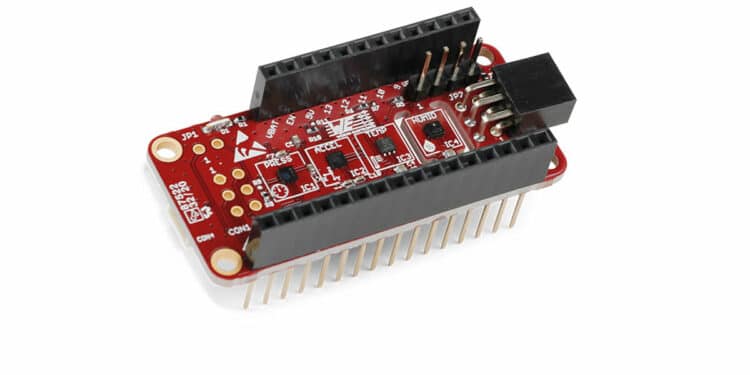Würth Elektronik presents a series of FeatherWings for the Feather development system from Adafruit.
The four FeatherWings are fully compatible with the Feather form factor. With these development boards stackable on Adafruit’s Feather microcontroller boards, Würth Elektronik brings wireless modules, sensors and power modules to the Feather ecosystem. The extensive documentation, C/C++ drivers and code examples facilitate the development of applications in the field of IoT, for example.
Sensor FeatherWing
The Sensor FeatherWing combines four sensors for temperature, absolute pressure, humidity and 3-axis acceleration, all connected via a common I²C bus. In addition to the Adafruit Feather form factor, the developer board with the precise MEMS sensors from Würth Elektronik is also compatible with the QWIIC connection system from SparkFun.
Thyone-I Wireless FeatherWing
This FeatherWing enables wireless connections of up to 500 meters range with a proprietary 2.4 GHz radio module. This can be used, for example, to set up mesh networks for IoT applications. The module has an integrated security/authentication IC and provides AES128 encryption of communications with other Thyone-I modules or the Thyone-I USB wireless stick. The WE-ProWare radio protocol is characterized by the fact that it can be configured for individual purposes with simple commands.
Calypso WiFi FeatherWing
The low-power WLAN interface for stacking on a Feather brings out-of-the-box implementation of several commonly used networking applications such as SNTP, DHPv4, DHCPv6, mDNS, HTTP(S) and MQTT. The Feather ecosystem is known to be powered by USB or a lithium-polymer battery – for battery-powered applications, the Calypso WiFi FeatherWing has a power-saving mode. The module can handle 2.4 GHz WiFi connections according to IEEE 802.11 b/g/n and supports IPv4 and IPv6 as well as encryption via TLS.
The magic of variable power supply
The MagI³C Power Modules from Würth Elektronik are easy-to-use DC/DC converters with integrated regulator IC, inductor and capacitors. With the MagI³C Power FeatherWing, these are now also available to developers for rapid prototyping with Adafruit Feather.
The FeatherWing converts input voltages from 6 V to 36 V into a constant output voltage of 5 V and thus covers the typical industrial bus voltages. A further MagI³C module on the PCB can reduce the output voltage even further to 3.3 V. Alternatively, the module can be operated at 5 V via a common USB connection. The MagI³C Power FeatherWing thus becomes the 5 V and 3.3 V power supply for the entire FeatherWing ecosystem and expands the possibilities for using it to build prototypes for industrial applications.
Application examples in the catalog
On the product pages and in the “Wireless Connectivity & Sensors” product guide, Würth Elektronik provides suggestions for applications that become possible with their contributions to the Adafruit Feather ecosystem. This includes, for example, the collection and forwarding of sensor data. A quickstart guide makes it easy to get started working with the developer boards.
A video about the Würth Elektronik FeatherWings is available on Adafruit’s blog here






